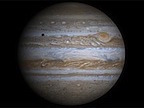You are here
Appendix G
The following table defines common octan units of measure,
and lists conversion factors to units widely used by both humans and simions (on planets Earth and Aerth, respectively).
In deference to human (and potential simion) readers, all numbers here and throughout the text are expressed in the decimal system, base ten.
Octos customarily express numbers in the octal system, base eight.
| Physical Quantity | Octan Unit | Definition | Human/Simion Equivalent |
| Time | noc | 1/64 nim | 1.09 seconds |
| nim | 1/64 roh | 1.16 minutes | |
| roh | 1/8 yad | 1.24 hours | |
| yad | local Jopitar day (deep interior) |
9.92 hours | |
| kew | 8 yads | 3.31 days | |
| thom | 8 kews | 26.5 days | |
| jope | local Jopitar year | 11.86 years | |
| kilujope | 83 jope | 6072 years | |
| megujope | 86 | 3.109 million years | |
| bevujope | 89 | 1.592 billion years | |
| Distance | centuret | 1/64 ret | 1.460 centimeters |
| ret | 8-6 depth of floating thickets | 0.935 meters | |
| kiluret | 83 ret | 0.479 kilometers | |
| meguret | 86 ret | 245.0 kilometers | |
| bevuret | 89 ret | 1.254 x 105 kilometers | |
| light jope | distance light travels in one jope | 1.122 x 1014 kilometers | |
| Mass | mag | mass of a 1 centuret cube of alpha-quartz |
8.246 grams |
| kilumag | 83 mags | 4.222 kilograms | |
| Pressure | rab | 8-3 atmospheric pressure at floating thickets |
0.1187 bars |
| Temperature | nevlu | 8-3 absolute temperature at floating thickets |
1.119 kelvin |
Time, distance, mass, and temperature are fundamental quantities in the modern octan system. The corresponding fundamental units yad, ret, mag, and nevlu were originally defined in terms of mean values at the heart of the South Equatorial Belt in the jope zero of the (archaic) calendar of Zuul. The commonly used jope and rab were then redefined in terms of the fundamental units, to match accepted values during that epoch. All the fundamental units were eventually redefined in a more precise, reproducible manner that still closely matched the original values, using dimensional universal physical constants.
Jopitar's rotation and the length of the yad were first inferred from observations of the coriolis force in the floating thickets. The standard deep-interior value was later refined through spacecraft measurements of radio emissions from Jopitar's magnetic field.
The kiluret, nevlu and rab scales were originally calibrated such that the numerical values of depth (beneath the tropopause), temperature, and pressure were all approximately 512 (which is 1,000 in the octo base-8 number system) at the level of the floating thickets. The value of the ret was then similar to a popular ancient unit of distance, based on the average length of the dextrous tentacle of a mature octo.
Octos frequently add prefixes to their basic units, to define convenient smaller or larger units.
Several of the units defined in the previous table are examples of this practice.
The following table lists and defines some of the most commonly used prefixes.
| Prefix | Definition |
| nanu | x 8-9 = x 1/512 x 1/512 x 1/512 |
| micru | x 8-6 = x 1/512 x 1/512 |
| millu | x 8-3 = x 1/512 |
| centu | x 8-2 = x 1/64 |
| octi | x 8-1 = x 1/8 |
| octu | x 8 |
| hectu | x 82 = x 64 |
| kilu | x 83 = x 512 |
| megu | x 86 = x 512 x 512 |
| bevu | x 89 = x 512 x 512 x 512 |
| teru | x 812 = x 512 x 512 x 512 x 512 |
